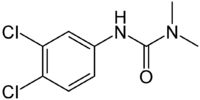- DCMU
-
DCMU  Other names3-(3,4-Dichlorophenyl)-1,1-dimethylurea
Other names3-(3,4-Dichlorophenyl)-1,1-dimethylureaIdentifiers CAS number 330-54-1 
ChemSpider 3008 
KEGG C18428 
ChEBI CHEBI:116509 
ChEMBL CHEMBL278489 
Jmol-3D images Image 1 - Clc1ccc(NC(=O)N(C)C)cc1Cl
Properties Molecular formula C9H10Cl2N2O Molar mass 233.09 g mol−1 Density 1.48 g/cm3 Melting point 158 °C, 431 K, 316 °F
Boiling point 180 °C, 453 K, 356 °F
Solubility in water 42 mg/L Hazards EU classification Harmful (Xn); Dangerous for the environment (N)  (verify) (what is:
(verify) (what is:  /
/ ?)
?)
Except where noted otherwise, data are given for materials in their standard state (at 25 °C, 100 kPa)Infobox references DCMU (3-(3,4-dichlorophenyl)-1,1-dimethylurea) is an herbicide that inhibits photosynthesis. It was introduced by Bayer in 1954 under the trade name of Diuron.
Mechanism of action
DCMU is a very specific and sensitive inhibitor of photosynthesis. It blocks the plastoquinone binding site of photosystem II, disallowing the electron flow from where it is generated, in photosystem II, to plastoquinone.[1] This interrupts the photosynthetic electron transport chain in photosynthesis and thus blocks the ability of the plant to turn light energy into chemical energy (ATP and reductant potential).
DCMU only blocks electron flow from photosystem II, it has no effect on photosystem I or other reactions in photosynthesis, such as light absorption or carbon fixation in the Calvin cycle.
However, because it absorbs electrons oxidized from water in PS II, the electron "hole" of PS I cannot be satisfied, effectively shutting down photosynthesis by blocking the reduction of NADP+ to NADPH, and the cyclic photosynthetic pathway since electron shuttling is associated with proton pumping across the membrane into the lumen.
Because of these effects, DCMU is often used to study energy flow in photosynthesis.
References
- ^ Metz, J; Pakrasi, H; Seibert, M; Arntzer, C (1986). "Evidence for a dual function of the herbicide-binding D1 protein in photosystem II". FEBS Letters 205 (2): 269. doi:10.1016/0014-5793(86)80911-5.
Pest control: herbicides Anilides/Anilines acetochlor · alachlor · asulam · butachlor · diethatyl · diflufenican · dimethenamid · flamprop · metazachlor · metolachlor · pendimethalin · pretilachlor · propachlor · propanil · trifluralinAromatic acids Arsenicals Organophosphorus Phenoxy Pyridines Quaternary Triazines ametryn · atrazine · cyanazine · hexazinone · prometon · prometryn · propazine · simazine · simetryn · terbuthylazine · terbutrynUreas Others 3-AT · bromoxynil · clomazone · DCBN · dinoseb · juglone · mesotrione · methazole · metham sodium · sulfentrazoneCategories:- Herbicides
- Ureas
- Toxicology
- Anilines
- Organochlorides
Wikimedia Foundation. 2010.
